|
Pharmaco-electroencephalography
Electroencephalography (EEG) is the science of recording the spontaneous rhythmic electrical activity of a living brain through electrodes on the scalp. Brain rhythms have origins similar to the electrical activity of the heart. The rhythmic activity varies in frequency and amplitude with age, attention, sleep, and chemical concentrations of oxygen, carbon dioxide, glucose, ammonia, and hormones. Chemicals that affect brain functions change brain rhythms in systematic and identifiable ways. As new psychoactive drugs were discovered that changed behavior, the basis for the science of psychopharmacology, the accompanying changes in the rhythms were found to be drug class specific. The measurement of the changes in rhythms became the basis for the science of pharmaco-EEG. Definitions of the changes in EEG rhythms were developed that identified and classified psychoactive drugs, monitored the depth of anesthesia, and evaluated the efficacy of the seizures induced in convulsive therap ... [...More Info...] [...Related Items...] OR: [Wikipedia] [Google] [Baidu] |
Electroencephalography
Electroencephalography (EEG) is a method to record an electrogram of the spontaneous electrical activity of the brain. The biosignal, bio signals detected by EEG have been shown to represent the postsynaptic potentials of pyramidal neurons in the neocortex and allocortex. It is typically non-invasive, with the EEG electrodes placed along the scalp (commonly called "scalp EEG") using the 10–20 system (EEG), International 10–20 system, or variations of it. Electrocorticography, involving surgical placement of electrodes, is sometimes called Electrocorticography, "intracranial EEG". Clinical interpretation of EEG recordings is most often performed by visual inspection of the tracing or quantitative EEG, quantitative EEG analysis. Voltage fluctuations measured by the EEG bioamplifier, bio amplifier and electrodes allow the evaluation of normal Brain activity and meditation, brain activity. As the electrical activity monitored by EEG originates in neurons in the underlying Huma ... [...More Info...] [...Related Items...] OR: [Wikipedia] [Google] [Baidu] |
Psychopharmacology
Psychopharmacology (from Greek ; ; and ) is the scientific study of the effects drugs have on mood, sensation, thinking, behavior, judgment and evaluation, and memory. It is distinguished from neuropsychopharmacology, which emphasizes the correlation between drug-induced changes in the functioning of cells in the nervous system and changes in consciousness and behavior. The field of psychopharmacology studies a wide range of substances with various types of psychoactive properties, focusing primarily on the chemical interactions with the brain. The term "psychopharmacology" was likely first coined by David Macht in 1920. Psychoactive drugs interact with particular target sites or receptors found in the nervous system to induce widespread changes in physiological or psychological functions. The specific interaction between drugs and their receptors is referred to as " drug action", and the widespread changes in physiological or psychological function is referred to ... [...More Info...] [...Related Items...] OR: [Wikipedia] [Google] [Baidu] |
Chlorpromazine
Chlorpromazine (CPZ), marketed under the brand names Thorazine and Largactil among others, is an antipsychotic medication. It is primarily used to treat psychotic disorders such as schizophrenia. Other uses include the treatment of bipolar disorder, severe behavioral problems in children including those with attention deficit hyperactivity disorder, nausea and vomiting, anxiety before surgery, and hiccups that do not improve following other measures. It can be given orally (by mouth), by intramuscular injection (injection into a muscle), or intravenously (injection into a vein). Chlorpromazine is in the typical antipsychotic class, and, chemically, is one of the phenothiazines. Its mechanism of action is not entirely clear but is believed to be related to its ability as a dopamine antagonist. It has antiserotonergic and antihistaminergic properties. Common side effects include movement problems, sleepiness, dry mouth, low blood pressure upon standing, and incr ... [...More Info...] [...Related Items...] OR: [Wikipedia] [Google] [Baidu] |
Anxiolytic
An anxiolytic (; also antipanic or anti-anxiety agent) is a medication or other intervention that reduces anxiety. This effect is in contrast to anxiogenic agents which increase anxiety. Anxiolytic medications are used for the treatment of anxiety disorders and their related psychological and physical symptoms. Nature of anxiety Anxiety is a naturally-occurring emotion and response. When anxiety levels exceed the tolerability of a person, anxiety disorders may occur. People with anxiety disorders can exhibit fear responses, such as defensive behaviors, high levels of alertness, and negative emotions. Those with anxiety disorders may have concurrent psychological disorders, such as depression. Anxiety disorders are classified using six possible clinical assessments: Different types of anxiety disorders will share some general symptoms while having their own distinctive symptoms. This explains why people with different types of anxiety disorders will respond differently to diffe ... [...More Info...] [...Related Items...] OR: [Wikipedia] [Google] [Baidu] |
Antipsychotic
Antipsychotics, previously known as neuroleptics and major tranquilizers, are a class of Psychiatric medication, psychotropic medication primarily used to manage psychosis (including delusions, hallucinations, paranoia or disordered thought), principally in schizophrenia but also in a range of other psychotic disorders. They are also the mainstay, together with mood stabilizers, in the treatment of bipolar disorder. Moreover, they are also used as adjuncts in the treatment of Treatment-resistant depression, treatment-resistant major depressive disorder. The use of antipsychotics may result in many unwanted side effects such as Extrapyramidal symptoms, involuntary movement disorders, gynecomastia, impotence, weight gain and metabolic syndrome. Long-term use can produce List of long term side effects of antipsychotics, adverse effects such as tardive dyskinesia, tardive dystonia, Akathisia, tardive akathisia, and brain tissue volume reduction. The long term use of antipsychotics ... [...More Info...] [...Related Items...] OR: [Wikipedia] [Google] [Baidu] |
Deliriant
Deliriants are a subclass of hallucinogen. The term was coined in the early 1980s to distinguish these drugs from psychedelics such as LSD and dissociatives such as ketamine, due to their primary effect of causing delirium, as opposed to the more lucid and less disturbed states produced by other types of hallucinogens, where rational thought is better preserved (including the ability to distinguish hallucinations from reality). Duncan, D. F., and Gold, R. S. (1982). Drugs and the Whole Person. New York: John Wiley & Sons The term generally refers to anticholinergic drugs, which are substances that inhibit the function of the neurotransmitter acetylcholine. Common examples of deliriants include plants of the genera ''Datura'' and '' Brugmansia'', both containing scopolamine, as well as higher than recommended dosages of diphenhydramine (Benadryl). A number of plant deliriants such as that of the Solanaceae family, particularly in the Americas, have been used by some indi ... [...More Info...] [...Related Items...] OR: [Wikipedia] [Google] [Baidu] |
Euphoriant
Euphoria ( ) is the experience (or affect) of pleasure or excitement and intense feelings of well-being and happiness. Certain natural rewards and social activities, such as aerobic exercise, laughter, listening to or making music and dancing, can induce a state of euphoria. Euphoria is also a symptom of certain neurological or neuropsychiatric disorders, such as mania. Romantic love and components of the human sexual response cycle are also associated with the induction of euphoria. Certain drugs, many of which are addictive, can cause euphoria, which at least partially motivates their recreational use. Hedonic hotspots – i.e., the pleasure centers of the brain – are functionally linked. Activation of one hotspot results in the recruitment of the others. Inhibition of one hotspot results in the blunting of the effects of activating another hotspot. Therefore, the simultaneous activation of every hedonic hotspot within the reward system is believed to be neces ... [...More Info...] [...Related Items...] OR: [Wikipedia] [Google] [Baidu] |
Naloxone
Naloxone, sold under the brand name Narcan among others, is an opioid antagonist, a medication used to reverse or reduce the effects of opioids. For example, it is used to restore breathing after an opioid overdose. Effects begin within two minutes when given intravenously, five minutes when injected into a muscle, and ten minutes as a nasal spray. Naloxone blocks the effects of opioids for 30 to 90 minutes. Administration to opioid-dependent individuals may cause symptoms of opioid withdrawal, including restlessness, agitation, nausea, vomiting, a fast heart rate, and sweating. To prevent this, small doses every few minutes can be given until the desired effect is reached. In those with previous heart disease or taking medications that negatively affect the heart, further heart problems have occurred. It appears to be safe in pregnancy, after having been given to a limited number of women. Naloxone is a non-selective and competitive opioid receptor antagonist. It revers ... [...More Info...] [...Related Items...] OR: [Wikipedia] [Google] [Baidu] |
Cyclazocine
Cyclazocine is a mixed opioid agonist/antagonist related to dezocine, pentazocine and phenazocine. It is in the benzomorphan and benzazocine family of drugs. It is a κ-opioid receptor agonist and μ-opioid receptor partial agonist, and also has high affinity for the δ-opioid receptor The δ-opioid receptor, also known as delta opioid receptor or simply delta receptor, abbreviated DOR or DOP, is an inhibitory 7-transmembrane G-protein coupled receptor coupled to the G protein Gi alpha subunit, Gi/G0 and has enkephalins as it .... Research Research into the use of cyclazocine for the treatment of bipolar patients with depression was undertaken by Fink and colleagues (1970). It showed that 8 out of 10 patients experienced moderate improvement. Research during the 1960s and 1970s into the possible use of cyclazocine for management of pain, and later for assisting treatment of opioid addiction was severely hampered by the drug's psychotomimetic, dysphoric, and hallucina ... [...More Info...] [...Related Items...] OR: [Wikipedia] [Google] [Baidu] |
Methadone
Methadone, sold under the brand names Dolophine and Methadose among others, is a synthetic opioid used medically to treat chronic pain and opioid use disorder. Prescribed for daily use, the medicine relieves cravings and opioid withdrawal symptoms. Withdrawal management using methadone can be accomplished in less than a month, or it may be done gradually over a longer period of time, or simply maintained for the rest of the patient's life. While a single dose has a rapid effect, maximum effect can take up to five days of use. After long-term use, in people with normal liver function, effects last 8 to 36 hours. Methadone is usually taken by mouth and rarely by intramuscular, injection into a muscle or intravenous, vein. Side effects are similar to those of other opioids. These frequently include dizziness, Somnolence, sleepiness, nausea, vomiting, and Perspiration, sweating. Serious risks include opioid abuse and respiratory depression. Heart arrhythmia, Abnormal heart rhythm ... [...More Info...] [...Related Items...] OR: [Wikipedia] [Google] [Baidu] |
Psychopharmacology
Psychopharmacology (from Greek ; ; and ) is the scientific study of the effects drugs have on mood, sensation, thinking, behavior, judgment and evaluation, and memory. It is distinguished from neuropsychopharmacology, which emphasizes the correlation between drug-induced changes in the functioning of cells in the nervous system and changes in consciousness and behavior. The field of psychopharmacology studies a wide range of substances with various types of psychoactive properties, focusing primarily on the chemical interactions with the brain. The term "psychopharmacology" was likely first coined by David Macht in 1920. Psychoactive drugs interact with particular target sites or receptors found in the nervous system to induce widespread changes in physiological or psychological functions. The specific interaction between drugs and their receptors is referred to as " drug action", and the widespread changes in physiological or psychological function is referred to ... [...More Info...] [...Related Items...] OR: [Wikipedia] [Google] [Baidu] |





